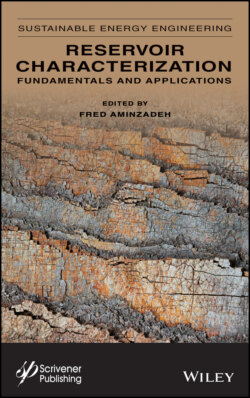Читать книгу Reservoir Characterization - Группа авторов - Страница 26
1.6.1 Rock Physics
ОглавлениеRock physics investigates reservoir rocks properties that affect transmission of seismic waves through the rocks. These physical properties are rigidity, compressibility, and porosity. This provides a connection between elastic properties measured at the surface of the earth, within the borehole environment or in the laboratory with the intrinsic properties of rocks, such as mineralogy, porosity, pore shapes, pore fluids, pore pressures, permeability, viscosity, stresses and overall architecture such as laminations and fractures.
Description of rock and fluid properties between the well control points requires understanding of the linkage of bulk and seismic properties to each other and their changes with geologic age, burial depth, and location. This connection allows us to understand and model the petrophysical and geometrical properties which give rise to the seismic signal. Rock physics requires a knowledge and understanding of geophysics, petrophysics, geomechanics and the causes of distribution of fluids in the subsurface reservoir between wells. From seismic fluid monitoring we can obtain valuable information about reservoir fluid movements and geologic reservoir heterogeneities. The results can also resolve seal integrity issues and guide the optimum placement of wells in complex reservoirs.
Rock physics uses sonic, density and dipole sonic logs to establish a relationship between the geophysical data and the petrophysical properties. In ‘80s and ‘90s many oil companies had their own rock physics laboratories. Because of the longer-range objectives and the need to assemble large databases, today such laboratories are found primarily within five or six universities and a few service companies. The focus of rock physics analysis started with estimating porosity and permeability of sandstones and carbonates. Today, much of the research is focused on unconventional reservoirs and on estimating rock strength or “fracability” and the presence of total organic carbon. For some detailed discussion on the value of rock physics analysis in various aspects of reservoir characterization and reservoir property estimation see Dvorkin and Nur [5] and Castagna et al. [4].
Integration of 3D seismic interpretation with well measurements provides a powerful tool for characterization a reservoir for the 3D distribution of rock properties and the geometric framework of the reservoir. While the cores, wireline logs and outcrops provide the vertical resolution it is only geophysical data like 3D seismic data that can provide detailed spatial information between the wells for the geological model. Since 3D seismic is a measurement made at the surface of the earth, the subsurface interpretation using seismic data can be done only after proper calibration with available well information. Seismic reflection data provide the gross acoustic properties within a volume of rock and do not have the vertical resolution of wireline logs.
